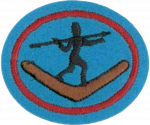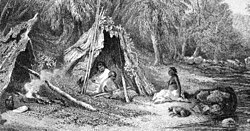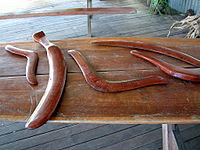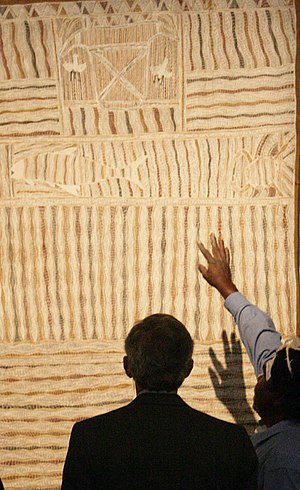Difference between revisions of "AY Honors/Aboriginal Lore/Answer Key/es"
(Created page with "==3. Discutir el alimento de los aborígenes:== ===a. Clases===") |
(Created page with "===c. ¿Cómo lo preparan?===") |
||
| Line 36: | Line 36: | ||
{{clear}} | {{clear}} | ||
| − | ===b. | + | ===b. ¿Cómo lo obtienen?=== |
| − | |||
| − | |||
| − | + | {{clear}} | |
| − | |||
| − | |||
| − | |||
| − | |||
{{clear}} | {{clear}} | ||
| Line 50: | Line 44: | ||
{{clear}} | {{clear}} | ||
| − | ===c. | + | ===c. ¿Cómo lo preparan?=== |
| − | |||
{{clear}} | {{clear}} | ||
Revision as of 21:23, 1 December 2014
| Folclore de Aborígenes Australianos | ||
|---|---|---|
| División del Pacífico Sur
|
Destreza: 1 Año de introducción: Desconocido |
|
Requisitos
1. ¿Quiénes son los aborígenes y de dónde han venido? ¿Cuántas tribus había allí cuando comenzó la colonización europea?
2. Discutir el sistema tribal. ¿Qué son los tótems?
3. Discutir el alimento de los aborígenes:
a. Clases
b. ¿Cómo lo obtienen?
c. ¿Cómo lo preparan?
4. Discuss their homes. Of what are they made and why are they not permanent? Where do the young men and boys sleep?
5. How do they communicate with other tribes who may not understand their language? How do they send signals within the tribe? What is the purpose of the Tjuringa (or Churinga)?
Communication with other tribes
A message stick is a form of communication traditionally used by the Aborigines. It is usually a solid piece of wood, around 20–30cm in length, etched with angular lines and dots.
6. What are some of the articles of trade and exchange? What domestic utensils do they use.
Articles of Trade
7. Describe some of the weapons used in hunting and warfare.
Boomerang and Throwing Sticks
Boomerangs are curved pieces of wood used as weapons and sport equipment. Boomerangs come in many shapes and sizes depending on their geographic or tribal origins and intended function. The most recognisable type is the returning boomerang, which is a throwing stick that travels in a elliptical path and returns to its point of origin when thrown correctly. Although non-returning boomerangs (throw sticks or kylie's) were used as weapons, returning boomerangs have only ever been used for leisure or recreation.
8. What is a corroboree? Explain its purpose. What are clap sticks and the didgeridoo?
Corroboree
A corroboree is a ceremonial meeting of Australian Aborigines. The word was coined by the European settlers of Australia in imitation of the Aboriginal word caribberie. At a corroboree Aborigines interact with the Dreamtime through dance, music and costume. Many ceremonies act out events from the Dreamtime. Many of the ceremonies are sacred and people from outside a community are not permitted to participate or watch.
In the northwest of Australia, corroboree is a generic word to define theatrical practices as different from ceremony. Whether it be public or private, ceremony is for invited guests. There are other generic words to describe traditional public performances: juju and kobbakobba for example. In the Pilbara, corroborees are yanda or jalarra. Across the Kimberley the word junba is often used to refer to a range of traditional performances and ceremionies.
Corroboree is a generic word to explain different genres of performance which in the northwest of Australia include balga, wangga, lirrga, junba, ilma and many more. Throughout Australia the word corroboree embraces songs, dances, rallies and meetings of various kinds. In the past a corroboree has been inclusive of sporting events and other forms of skill display. It is an appropriated English word that has been reappropriated to explain a practice that is different to ceremony and more widely inclusive than theatre or opera.
Clap sticks and the didgeridoo
Aboriginal people developed unique instruments and folk styles. The didgeridoo is commonly considered the national instrument of Aboriginal people, and it is claimed to be the world's oldest wind instrument. However, it was traditionally only played by Arnhem Land people, such as the Yolngu, and then only by the men. It has possibly been used by the people of the Kakadu region for 1500 years. Clap sticks are probably the more ubiquitous musical instrument, especially because they help maintain the rhythm for the song.
9. What games do children play? How are young men trained? How are they initiated? What is the bora ground? What is a bull roarer?
Games
Marn Grook (also spelt marngrook), literally meaning "Game ball", is the collective name given to a number of traditional Indigenous Australian ball games believed to have been played at gatherings and celebrations of up to 50 players.
10. Discuss the two main types of Aboriginal art.
There are many "types" of Aboriginal art, but the two most famous types appear to be bark painting and rock art.
Bark Painting
Bark painting is an Australian Aboriginal art-form which is done on the interior strip of a tree bark. Traditionally, bark paintings were produced for instructional and ceremonial purposes and were transient objects. Today, they are keenly sought after by collectors and public arts institutions.
11. Briefly relate the history of the Aborigines since the white man arrived in Australia, mentioning the government policies through the years and the work of missions.
1788-1900
In 1770, Lieutenant James Cook claimed the east coast of Australia in the name of Great Britain and named it New South Wales. British colonisation of Australia began in Sydney in 1788. The most immediate consequence of British settlement – within weeks of the first colonists' arrival – was a wave of European epidemic diseases such as chickenpox, smallpox, influenza and measles, which spread in advance of the frontier of settlement. The worst-hit communities were the ones with the greatest population densities, where disease could spread more readily. In the arid centre of the continent, where small communities were spread over a vast area, the population decline was less marked.
Referencias
- Categoría: Tiene imagen de insignia
- Adventist Youth Honors Answer Book/Honors/es
- Adventist Youth Honors Answer Book/es
- Adventist Youth Honors Answer Book/Skill Level 1/es
- Categoría: Libro de respuestas de especialidades JA/Especialidades introducidas en Desconocido
- Adventist Youth Honors Answer Book/South Pacific Division/es
- Adventist Youth Honors Answer Book/Unknown/es
- Adventist Youth Honors Answer Book/Unknown/Primary/es
- Adventist Youth Honors Answer Book/Stage 100/es
- Adventist Youth Honors Answer Book/Completed Honors








